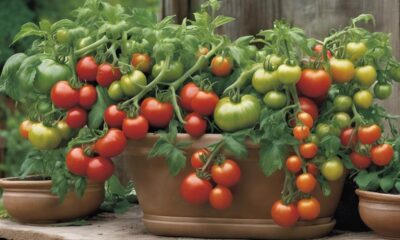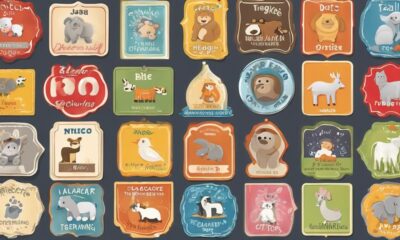Christmas Decoration
What Christmas Decoration Is Made From a Parasitic Plant
2025
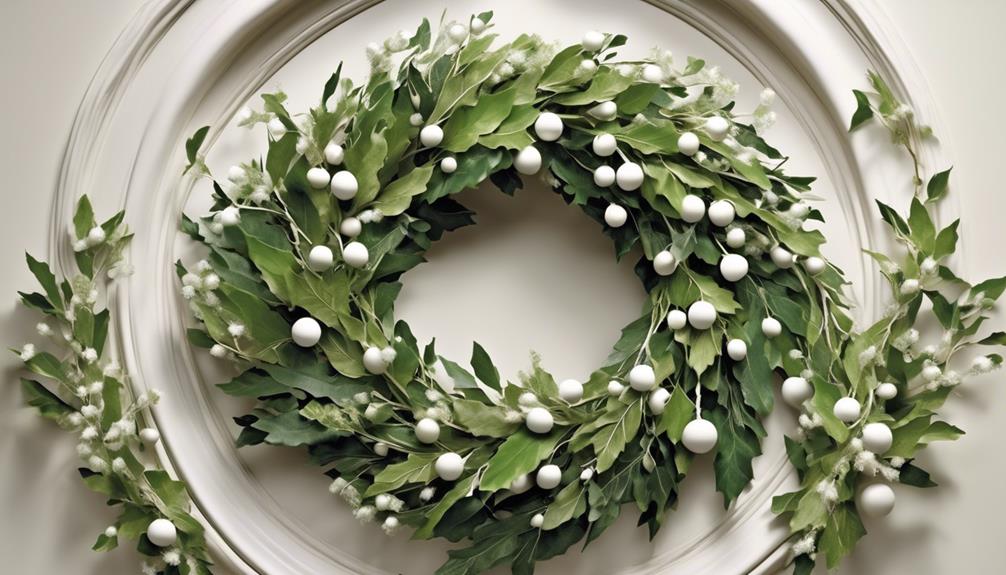
Interestingly, a lot of people might not be aware that the festive symbol of Christmas, mistletoe, originates from a parasite plant. It’s fascinating to see a parasitic plant become associated with holiday celebrations.
In our exploration, we'll delve into the origins of mistletoe as a decoration, its parasitic nature, and its cultural significance. We'll also examine its historical use in festive decor, its role in mythology and folklore, and its ecological impact.
Furthermore, we'll discover the global variations in mistletoe customs and explore conservation and sustainable practices related to its usage. Join us as we unravel the fascinating story behind this unique Christmas decoration.
Key Takeaways
- Mistletoe is a parasitic plant that grows on the branches of trees and derives water and nutrients from them.
- Despite its parasitic nature, mistletoe provides food and shelter for bird species and promotes biodiversity.
- Mistletoe has a long history of cultural significance, symbolizing peace, love, fertility, and protection.
- Harvesting mistletoe for Christmas decorations requires careful consideration of sustainable practices, such as selecting the right host tree and using non-invasive harvesting methods.
Origins of Mistletoe as a Decoration
The use of mistletoe as a decoration has a long history, intertwined with ancient folklore and cultural traditions. Mistletoe, a semi-parasitic plant, has its origins in the ancient beliefs of the Celtic druids, who revered the plant for its seemingly magical properties. It was considered a symbol of fertility and vitality, and was believed to have the power to bring good fortune and ward off evil spirits. The cultural significance of mistletoe continued to evolve over time, and it became incorporated into various European traditions, eventually finding its way into the Christmas customs we observe today.
Botanically speaking, mistletoe is a fascinating plant that grows on the branches of trees, deriving some of its nutrients from its host while also photosynthesizing on its own. There are several species of mistletoe, each with its own unique characteristics and preferred host trees. Its distinctive evergreen leaves and white berries make it a visually striking addition to any festive decoration.
Understanding the origins and cultural significance of mistletoe provides a deeper appreciation for this age-old tradition and the botanical marvel that it represents.
Mistletoe's Parasitic Nature
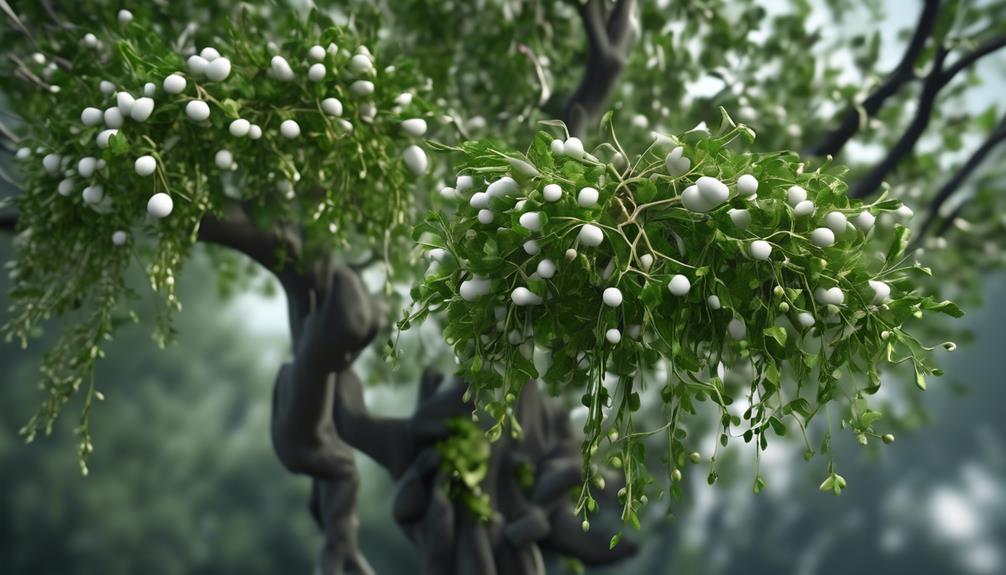
Mistletoe exhibits a unique parasitic nature, attaching itself to the branches of host trees and deriving water and nutrients from them. This parasitic relationship has significant ecological impact, affecting the growth and health of the host tree. Here are some fascinating points about mistletoe's parasitic nature:
- Mistletoe's specialized roots, called haustoria, penetrate the host tree's vascular system, allowing it to extract water and nutrients directly.
- The presence of mistletoe can weaken the host tree, making it more susceptible to other stressors such as drought and diseases.
- Despite its parasitic nature, mistletoe plays a crucial role in providing food and shelter for various bird species, thereby contributing to the diversity of ecosystems.
- In some cultures, mistletoe symbolism extends beyond Christmas traditions, with associations to fertility, protection, and healing, adding to its cultural significance.
- Understanding mistletoe's parasitic nature sheds light on the delicate balance within ecosystems and the intricate interplay between organisms.
Mistletoe's parasitic nature underscores the complexities of ecological relationships and the interconnectedness of species within natural environments.
Cultural Significance of Mistletoe
Mistletoe holds a rich cultural significance, symbolizing peace, love, and fertility in various traditions. It has been used in rituals and ceremonies by different cultures for centuries, often representing protection and healing.
The traditional custom of kissing under the mistletoe during the holiday season is just one example of its enduring cultural importance.
Symbolism of Mistletoe
While mistletoe has been traditionally associated with holiday traditions and romantic customs, its cultural significance extends beyond its decorative use.
In various cultures, mistletoe symbolism and cultural significance include:
- Sacred Plant: Mistletoe was revered by ancient druids as a symbol of fertility and vitality, often used in religious ceremonies.
- Healing Properties: Some cultures believed mistletoe to have medicinal properties, using it to treat various ailments and diseases.
- Symbol of Peace: Norse mythology considered mistletoe a symbol of love and friendship, promoting peace and reconciliation when found growing on oak trees.
- Renewal and Rebirth: Due to its ability to thrive in winter, mistletoe symbolizes resilience, renewal, and the enduring cycle of life.
- Spiritual Protection: In some traditions, mistletoe was hung in homes to ward off evil spirits and bring good luck to the household.
Traditional Uses of Mistletoe
Revered by ancient druids for its fertility and vitality symbolism, mistletoe holds a rich cultural significance with traditional uses extending beyond its decorative role in holiday traditions.
In traditional customs, mistletoe has been utilized for its medicinal properties, particularly in the treatment of hypertension and epilepsy.
Furthermore, mistletoe plays a crucial ecological role, providing food and habitat for various bird species during the winter months. Its impact on ecosystems is notable, as it often grows on a variety of tree species, influencing forest dynamics.
Additionally, mistletoe has been used in folklore and traditional medicine across cultures for its purported healing properties.
This parasitic plant continues to be a subject of scientific interest due to its potential pharmaceutical applications, further enriching the cultural and ecological significance of mistletoe.
Historical Use in Festive Decor
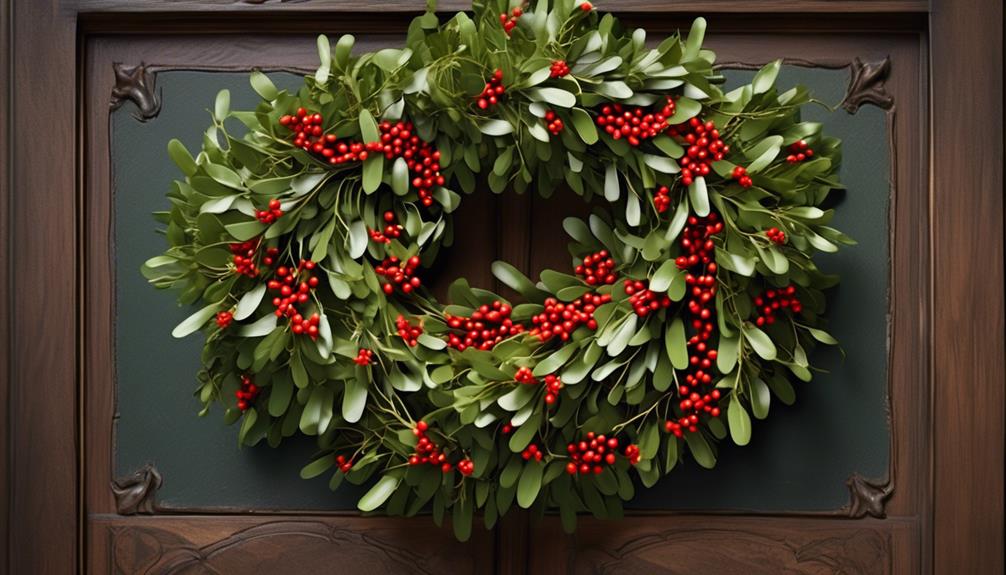
Throughout history, the use of mistletoe in festive decorations has been a longstanding tradition, dating back to ancient cultures and civilizations. Mistletoe holds significant historical significance as it was revered by the ancient Druids for its healing properties and fertility symbolism.
The festive symbolism of mistletoe can be traced to Norse mythology, where it was associated with love and peace. In ancient Greece, it was believed to bring about good luck and ward off evil spirits during the winter solstice.
The tradition of hanging mistletoe as a decoration during the Christmas season has been passed down through generations, symbolizing goodwill and romance. The continued use of mistletoe in festive decor signifies the enduring legacy of this botanical tradition, connecting us to our ancestors and their beliefs. Its association with love and unity makes it a cherished element of holiday celebrations, encouraging people to come together and share moments of joy. For many, the best time for Christmas decorations is also an opportunity to reflect on the meanings behind such traditions, creating a deeper connection to the season. Mistletoe, with its rich history, remains a timeless symbol of the holiday spirit, bridging the past and present with its charm. Its presence in the holiday home not only adds a touch of natural beauty but also invites conversations about the origins of such customs. As families gather to decide when to put up decorations, many find joy in revisiting the stories and significance behind items like mistletoe, deepening their appreciation for these time-honored practices. In this way, the act of decorating becomes more than just preparation for the season—it transforms into a celebration of heritage and connection.
Its historical use in festive decor serves as a reminder of the cultural significance and symbolic meaning attached to this revered plant.
- The ancient Druids revered mistletoe for its healing properties and fertility symbolism.
- Norse mythology associated mistletoe with love and peace.
- In ancient Greece, mistletoe was believed to bring about good luck and ward off evil spirits during the winter solstice.
- Mistletoe has been passed down through generations, symbolizing goodwill and romance.
- The tradition of hanging mistletoe during the Christmas season connects us to our ancestors and their beliefs.
Mistletoe in Mythology and Folklore
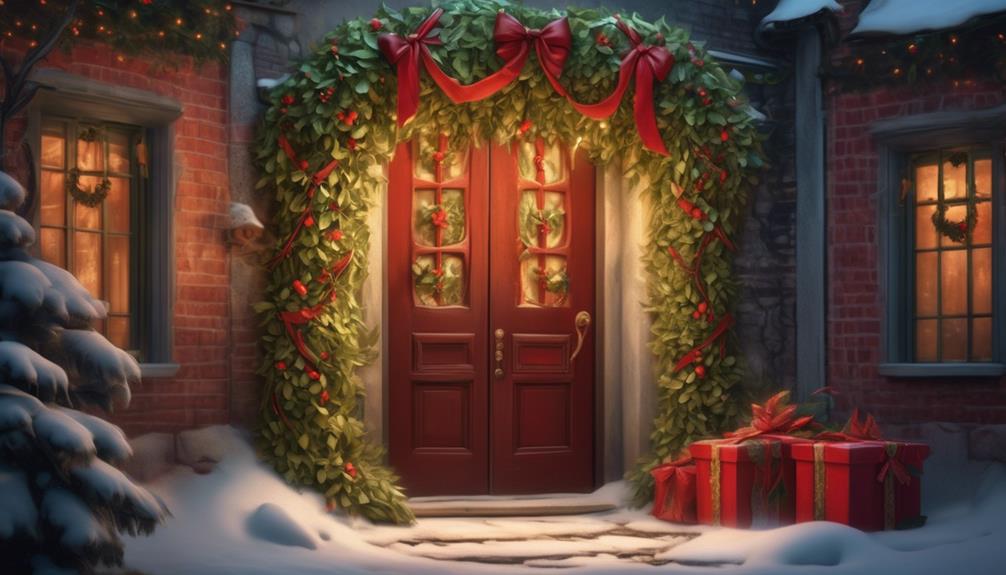
Mistletoe has played a significant role in mythology and folklore, featuring prominently in various cultural narratives and traditional beliefs. In ancient Norse mythology, mistletoe was associated with Frigga, the goddess of love and beauty. The plant became a symbol of love, friendship, and goodwill, leading to the tradition of kissing under the mistletoe during the holiday season. Additionally, mistletoe's unique growth habits, thriving as a parasitic plant on trees, contributed to its symbolism in various cultures. The following table summarizes mistletoe symbolism and history:
| Symbolism | Description |
|---|---|
| Love and fertility | Mistletoe was considered a symbol of fertility and vitality in Celtic beliefs |
| Protection | Ancient Greeks believed mistletoe possessed protective powers against evil |
| Renewal | Druids viewed mistletoe as a symbol of life and fertility, representing renewal and abundance |
Mistletoe's rich history and symbolism have made it an enduring element in cultural traditions and folklore, adding depth and meaning to its use as a Christmas decoration.
Botanical Characteristics of Mistletoe
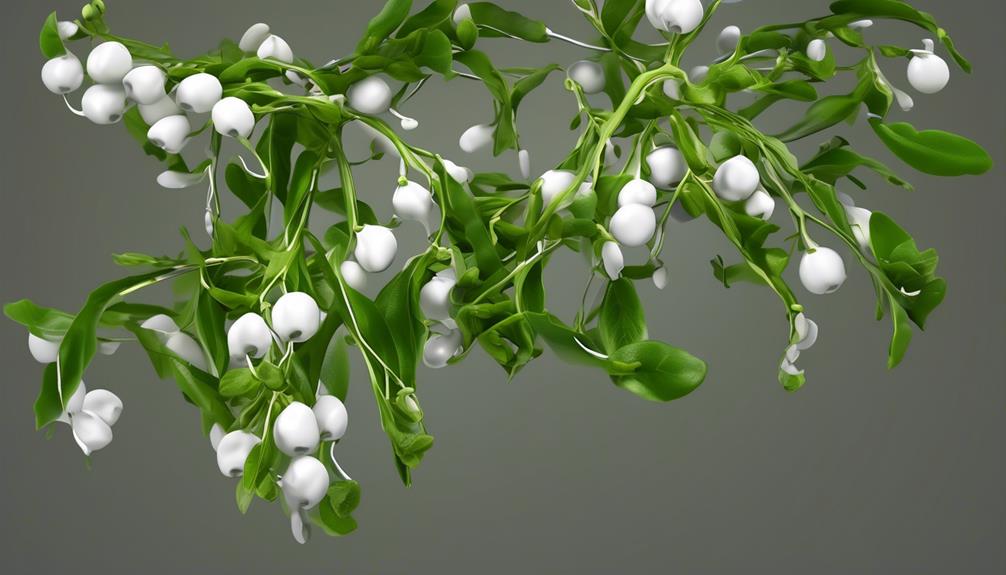
Growing exclusively as a parasitic plant on the branches of host trees, mistletoe exhibits unique botanical characteristics that distinguish it from other plants. Mistletoe has evolved remarkable botanical adaptations to thrive in its ecological niche. These adaptations include:
- Viscin: Mistletoe produces a viscous adhesive substance that allows it to firmly attach to the branches of its host tree, enabling it to extract water and nutrients.
- Reduced leaves: Mistletoe's leaves are reduced to scales, minimizing water loss and maximizing efficiency in nutrient uptake from the host tree.
- Photosynthesis: While mistletoe is capable of photosynthesis, it also relies on its host tree for some nutrients, demonstrating a unique ecological impact on the host tree's physiology.
- Berries: Mistletoe produces distinctive white berries that are toxic to humans but serve as a vital food source for birds during the winter months, promoting biodiversity.
- Seed dispersal: Mistletoe seeds are spread by birds that consume the berries, aiding in the plant's propagation and contributing to the dispersal of genetic diversity.
These botanical characteristics highlight the intricate relationship between mistletoe and its host trees, underscoring the fascinating ecological impact of this parasitic plant.
Traditional Mistletoe Decorations
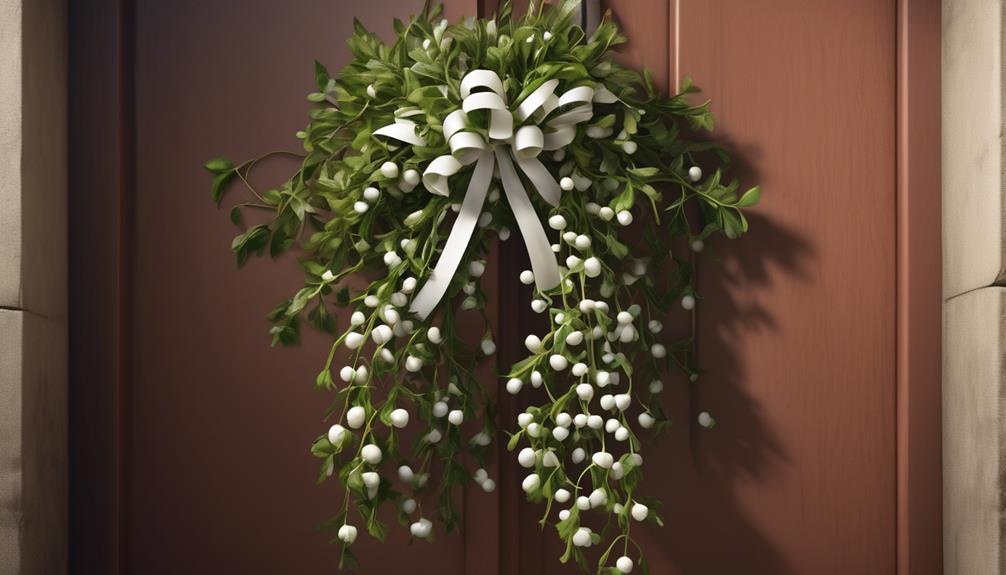
Mistletoe has a long history of being used in traditional Christmas decorations, with origins dating back to ancient European cultures. The plant holds symbolic significance in these traditions, often representing love, fertility, and protection.
Harvesting and using mistletoe for decorations involves careful consideration of its growth and sustainability, making it an intriguing botanical element in holiday celebrations.
Origins of Mistletoe
While often associated with Christmas traditions, mistletoe has a fascinating botanical and cultural history that dates back centuries. Mistletoe symbolism is deeply rooted in various mythologies and ancient traditions, making it a captivating subject of study. Here are a few remarkable points about the origins of mistletoe:
- Druids believed mistletoe had magical properties, using it in rituals and as a symbol of fertility.
- Norse mythology tells the story of the god Baldur, who was killed by an arrow made of mistletoe.
- Mistletoe was used in ancient Greek rituals and associated with the goddess of love, Aphrodite.
- In traditional medicine, mistletoe was used to treat ailments and was believed to have healing powers.
- The parasitic nature of mistletoe adds to its mystique, as it grows on and derives nutrients from host trees, creating a unique botanical relationship.
Mistletoe's rich history and cultural significance make it a captivating subject for exploration.
Symbolism in Tradition
In traditional Christmas decorations, mistletoe is often used to symbolize love and fertility, with its evergreen leaves and white berries adding a touch of natural beauty to the festive ambiance. Mistletoe holds deep cultural significance, dating back to ancient times, where it was revered as a symbol of life and vitality. The use of mistletoe in holiday decor is rooted in its mythology and folklore, where it was believed to possess mystical powers of protection, healing, and fertility. The tradition of kissing under the mistletoe further emphasizes its symbolism of love and romance. Below is a table detailing the symbolism and cultural significance of mistletoe in tradition:
| Symbolism | Cultural Significance |
|---|---|
| Love and Fertility | Associated with romance and prosperity |
| Evergreen Leaves | Symbol of life and vitality |
| White Berries | Represent purity and healing |
Harvesting and Use
Harvesting mistletoe involves identifying host trees, typically deciduous species such as oak or apple, and carefully cutting the parasitic plant from its host using sharp, sterile tools to ensure proper handling and preservation.
The traditional uses of mistletoe include:
- Creating decorative arrangements for doorways
- Crafting festive kissing balls for holiday gatherings
- Incorporating mistletoe into wreaths for seasonal adornment
- Using mistletoe sprigs to symbolize love and friendship
- Employing mistletoe in traditional herbal remedies for various ailments
Mistletoe harvesting requires a deep understanding of the botanical characteristics of both the host trees and the mistletoe itself. The process demands precision and care to ensure the preservation of mistletoe's vibrant greenery.
Its traditional uses have been passed down through generations, adding a touch of natural beauty and symbolism to festive occasions.
Mistletoe in Modern Celebrations

During the holiday season, mistletoe serves as a symbol of love and tradition, enriching modern celebrations with its parasitic yet festive presence. Modern traditions and festive customs have kept mistletoe at the heart of holiday decorations for centuries, attributing mystical and cultural significance to this fascinating plant. The tradition of hanging mistletoe and exchanging kisses underneath it is a well-known custom in many parts of the world.
| Mistletoe in Modern Celebrations |
|---|
| Symbolism |
| Mistletoe symbolizes love, renewal, and friendship, adding a touch of romance to holiday gatherings. It is often used as a decoration, bringing a sense of warmth and tradition to modern celebrations. |
| Cultural Significance |
| In modern times, mistletoe has become an integral part of Christmas and New Year's traditions, serving as a reminder of the importance of love and connection during the holiday season. |
| Decorative Use |
| Mistletoe is commonly used in wreaths, centerpieces, and other festive arrangements, providing a unique and visually appealing touch to holiday décor. |
| Social Tradition |
| The tradition of kissing under the mistletoe has evolved into a lighthearted custom, bringing people together and fostering a sense of joy and unity during the holiday season. |
| Botanical Intrigue |
| From a botanical perspective, mistletoe's unique growth habits and evergreen foliage make it a captivating addition to modern holiday decorations. |
Symbolism of Mistletoe in Christmas

Nurturing a rich history of symbolism, mistletoe plays a significant botanical role in the Christmas traditions of many cultures. This parasitic plant, often found on trees such as apple and oak, holds deep meaning in various traditions.
- Meaningful traditions: Mistletoe symbolizes peace, love, and goodwill in Celtic traditions, where enemies would lay down their arms and observe a truce if they met beneath a tree with mistletoe.
- Romantic traditions: In Norse mythology, mistletoe was associated with love and friendship, leading to the custom of kissing under the mistletoe, a tradition that evolved into a symbol of romance and fertility.
- Botanical significance: As a hemiparasitic plant, mistletoe has intrigued botanists for its unique ability to draw nutrients from its host tree while also photosynthesizing.
- Cultural diversity: Different cultures have incorporated mistletoe into their Christmas traditions, adding layers of symbolism and significance.
- Folklore and mythology: Mistletoe has been a subject of fascination in folklore and mythology, further enriching its symbolic value in Christmas traditions.
Mistletoe's meaningful and romantic symbolism has transcended time and cultural boundaries, making it a cherished part of Christmas celebrations worldwide.
Harvesting and Preparation of Mistletoe

When it comes to harvesting mistletoe, it's crucial to employ specific techniques to ensure the plant's sustainability.
The preparation process involves careful removal from the host tree and subsequent cleaning to remove any debris.
Sustainable mistletoe harvesting practices are essential to maintain the ecological balance and biodiversity of the ecosystem.
Mistletoe Harvesting Techniques
To ensure the optimal harvesting and preparation of mistletoe, it's essential to understand the specific growth patterns and host tree dependencies of this parasitic plant. Mistletoe, a hemiparasitic plant, relies on a host tree for water and minerals, making traditional techniques and sustainable practices crucial for its harvesting.
Here are some important considerations for mistletoe harvesting:
- Selecting the right host tree is essential for sustainable mistletoe harvesting.
- Harvesting mistletoe during its dormant phase ensures minimal disturbance to the host tree.
- Using sharp, sterile tools helps prevent damage to the mistletoe and its host.
- Properly drying and storing harvested mistletoe preserves its quality and efficacy.
- Understanding the ecological impact of mistletoe harvesting ensures responsible and sustainable practices.
These practices are fundamental for maintaining the delicate balance between mistletoe harvesting and the health of its host trees.
Mistletoe Preparation Process
During the mistletoe preparation process, it is crucial to employ meticulous harvesting and handling methods to ensure the plant's integrity and efficacy. Mistletoe harvesting involves cutting the plant from the host tree without damaging its structure. It's essential to gather mistletoe at the right time to preserve its potency. After harvesting, the plant undergoes a preservation process to maintain its quality for decorative and ceremonial use. Preservation techniques include drying the mistletoe in a well-ventilated area away from direct sunlight to prevent mold growth. Additionally, mistletoe can be preserved by storing it in airtight containers with a desiccant to maintain its color and flexibility. These methods help to ensure that mistletoe retains its symbolic significance and biological properties for the holiday season.
| Mistletoe Harvesting Techniques | Mistletoe Preservation |
|---|---|
| Cut from host tree carefully | Dry in a ventilated area away from sunlight |
| Harvest at the right time | Store in airtight containers with desiccant |
| Handle gently to preserve structure | Monitor for mold growth and maintain flexibility |
Sustainable Mistletoe Harvesting
Sustainable mistletoe harvesting and preparation entail employing meticulous techniques to ensure the plant's integrity and efficacy. When considering sustainable harvesting, it's crucial to assess the ecological impact and implement practices that preserve the mistletoe population for future generations.
Our approach involves:
- Utilizing non-invasive harvesting methods to minimize disturbance to host trees and their ecosystems.
- Monitoring mistletoe populations to prevent over-harvesting and preserve biodiversity.
- Promoting natural regeneration by leaving a portion of the plant intact during harvesting.
- Educating harvesters about the significance of sustainable practices to instill a sense of responsibility and stewardship.
- Collaborating with researchers to continuously improve harvesting techniques and understand the ecological interactions of mistletoe.
These efforts not only ensure the sustainability of mistletoe but also contribute to the conservation of its habitats.
Mistletoe's Role in Festive Traditions

Mistletoe, a parasitic plant commonly associated with Christmas traditions, plays a significant role in festive customs and folklore due to its intriguing botanical characteristics and historical symbolism. In the context of festive traditions, mistletoe has been symbolically linked to peace, love, and goodwill for centuries. This association has led to the widespread custom of kissing under the mistletoe during the holiday season, a practice with roots in Norse mythology and Celtic rituals. The use of mistletoe in festive decorations and traditions is a testament to the enduring influence of botanical symbolism on human culture.
| Mistletoe Symbolism | Festive Traditions |
|---|---|
| Peace and harmony | Kissing under |
| Love and fertility | the mistletoe |
| Protection | Festive decorations |
| Rebirth | Folklore |
The symbolism of mistletoe extends beyond mere ornamentation, as it has been deeply intertwined with various cultural and religious practices throughout history. Its significance in festive traditions serves as a reminder of the profound impact that botanical elements can have on human customs and beliefs.
Ecological Impact of Mistletoe Usage
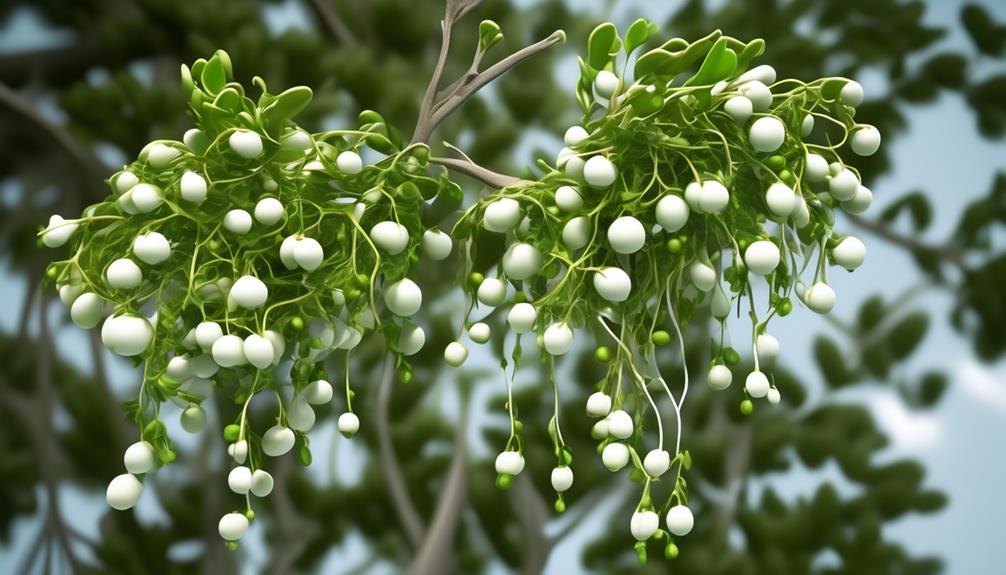
What ecological effects does the widespread use of mistletoe in festive decorations have on its host trees and surrounding ecosystem? The ecological impact of mistletoe usage is a topic that warrants attention due to its potential effects on the environment. When mistletoe is harvested unsustainably, it can lead to detrimental consequences for the ecological balance.
- Tree Health: The parasitic nature of mistletoe can weaken host trees, making them more susceptible to disease and other stressors.
- Biodiversity: Over-harvesting mistletoe can disrupt the delicate balance of the ecosystem, impacting the diversity of plant and animal species.
- Habitat Loss: Excessive mistletoe harvesting can lead to habitat loss for birds and other wildlife that depend on mistletoe for food and shelter.
- Soil Erosion: Weakening of host trees by mistletoe can contribute to soil erosion, affecting the overall stability of the ecosystem.
- Sustainable Practices: It's essential to promote sustainable harvesting practices and raise awareness about the ecological impact of mistletoe usage to ensure the preservation of our natural environment.
Understanding the ecological impact of mistletoe usage is crucial for promoting sustainable practices and preserving the delicate balance of our ecosystems.
Global Variations in Mistletoe Customs
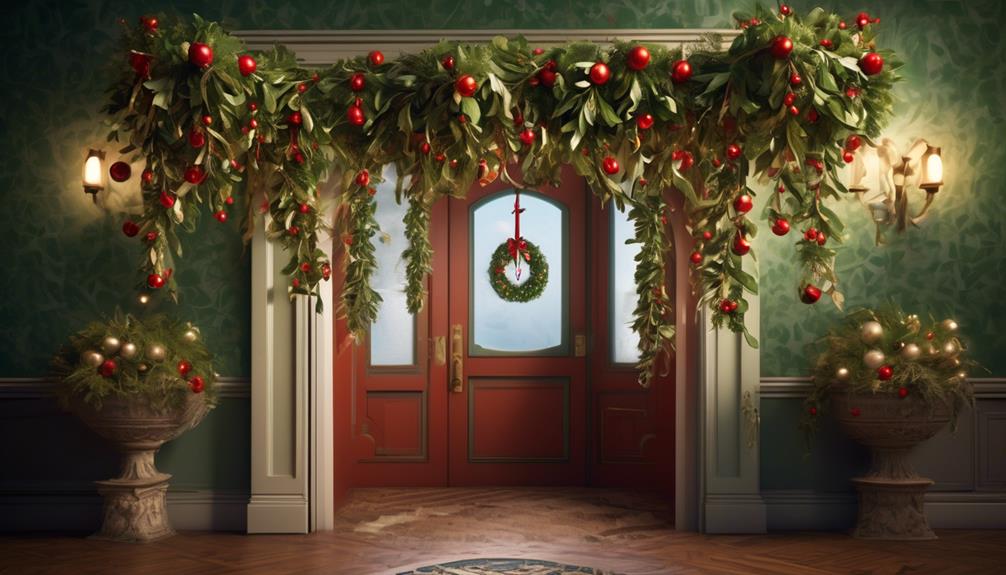
Mistletoe, known for its intriguing parasitic nature, holds a significant place in folklore and holiday traditions across the globe.
Our exploration of global variations in mistletoe customs will shed light on the diverse cultural significance of this botanical wonder.
From ancient rituals to modern-day customs, mistletoe's role in different societies offers a fascinating insight into the interconnectedness of botanical traditions and human culture.
Mistletoe in Folklore
Throughout various cultures around the world, mistletoe has been regarded as a symbol of fertility, protection, and healing, with customs and beliefs surrounding its significance differing widely. Mistletoe hasn't only found its way into festive decorations but has also made its mark in art and literature.
Here are some fascinating global variations in mistletoe customs:
- In Norse mythology, mistletoe was associated with the goddess of love, and it became a symbol of peace and love.
- Celtic druids considered mistletoe to have magical properties, using it in rituals for protection and healing.
- In ancient Greece, mistletoe was linked to the story of Aeneas, representing immortality and healing powers.
- Native American traditions saw mistletoe as a sacred plant with powerful healing properties.
- In some Asian cultures, mistletoe was believed to bring good luck and ward off evil spirits.
These diverse customs showcase the rich cultural significance of mistletoe.
Mistletoe in Holiday Traditions
In holiday traditions around the world, mistletoe, with its rich cultural significance, has been a symbol of love, protection, fertility, and healing, reflecting diverse customs and beliefs across different cultures.
This parasitic plant, known for its botanical characteristics, particularly its ability to grow on a wide range of host trees, plays a significant role in various ecosystems. Mistletoe's ecological impact is notable, as it provides food and shelter for birds and small mammals, contributing to the overall biodiversity of forests.
Additionally, its evergreen leaves and white berries have made it a popular choice for decorative use during the holiday season.
Understanding the global variations in mistletoe customs enriches our appreciation of the plant's cultural significance and ecological relevance, highlighting the interconnectedness of nature and human traditions.
Conservation and Sustainable Practices

Sustainably harvesting mistletoe for Christmas decorations requires careful consideration of its ecological impact and the use of responsible practices to ensure the preservation of this parasitic plant's natural habitats. Conservation practices, sustainable harvesting, environmental impact, and ethical sourcing are crucial aspects to protect mistletoe populations and their ecosystems.
- Conservation Practices: Implementing strategies such as controlled harvesting and reforestation to maintain mistletoe populations.
- Sustainable Harvesting: Utilizing methods that minimize harm to the host trees and ensure the long-term survival of mistletoe.
- Environmental Impact: Understanding the ecological role of mistletoe in its habitat and mitigating any negative effects caused by its removal.
- Ethical Sourcing: Engaging in transparent and responsible sourcing practices to support the conservation of mistletoe and its ecosystems.
- Biodiversity Preservation: Recognizing mistletoe's importance in supporting biodiversity and implementing measures to safeguard its role in the ecosystem.
Frequently Asked Questions
What Are the Potential Health Benefits of Mistletoe?
Potential health benefits of mistletoe include its traditional uses in treating conditions like hypertension and epilepsy.
Harvesting techniques involve careful removal from host trees to minimize ecological impact.
Studies suggest mistletoe extracts may have anticancer properties, although more research is needed.
Its medicinal potential is attributed to bioactive compounds like lectins and viscotoxins.
Mistletoe should be used cautiously due to toxicity, and consulting a healthcare professional is advisable.
Can Mistletoe Be Used in Cooking or Consumed in Any Way?
We often hear about mistletoe in the context of holiday decorations and traditions.
However, it's crucial to highlight the potential dangers of consuming mistletoe. Mistletoe is toxic and shouldn't be used in recipes or consumed in any way. It contains substances that can be harmful to humans and animals.
Therefore, it's important to exercise caution and avoid ingesting mistletoe in any form.
Are There Any Superstitions or Taboos Associated With Mistletoe in Different Cultures?
Superstitions and cultural beliefs surrounding mistletoe vary widely. In some cultures, mistletoe is considered a powerful symbol of fertility, love, and protection. Medicinally, it has been used to treat various ailments.
Harvesting rituals and ceremonial practices also differ among different communities. Understanding the diverse beliefs and practices associated with mistletoe can provide valuable insights into the intersection of folklore, botany, and cultural traditions.
How Does Mistletoe Affect the Trees It Grows On, and What Measures Can Be Taken to Mitigate Its Impact?
Mistletoe, a parasitic plant, significantly impacts tree health by sapping nutrients and water. To mitigate its impact, we can carefully prune infected branches.
Mistletoe's presence disrupts ecosystem balance by altering the tree's growth patterns and reducing its ability to defend against pests and diseases. Therefore, proactive measures are essential to maintain the overall health of the affected trees and preserve the ecological equilibrium of the surrounding environment.
Are There Any Specific Rituals or Ceremonies Associated With the Harvesting and Preparation of Mistletoe?
Harvesting mistletoe involves specific rituals to ensure its potency and ceremonial preparation. The process begins with identifying the host tree, followed by cutting the mistletoe during the waning phase of the moon to enhance its mystical properties.
Afterward, the mistletoe is carefully dried and ritually blessed before being used in various traditions and customs. These rituals are crucial in honoring the plant's sacred significance and ensuring its effectiveness in festive ceremonies.
Conclusion
In conclusion, mistletoe, a parasitic plant, has been a longstanding tradition in festive decor across various cultures. Its unique ecological impact and cultural significance make it a fascinating subject of study.
As we continue to embrace global variations in mistletoe customs, it's important to consider conservation and sustainable practices to ensure the preservation of this botanical marvel for future generations to enjoy.
- About the Author
- Latest Posts
Introducing Ron, the home decor aficionado at ByRetreat, whose passion for creating beautiful and inviting spaces is at the heart of his work. With his deep knowledge of home decor and his innate sense of style, Ron brings a wealth of expertise and a keen eye for detail to the ByRetreat team.
Ron’s love for home decor goes beyond aesthetics; he understands that our surroundings play a significant role in our overall well-being and productivity. With this in mind, Ron is dedicated to transforming remote workspaces into havens of comfort, functionality, and beauty.

‘Tis the time to decorate the halls and embrace the magic of Christmas! As I surround myself with the festive spirit of the holidays, I am enchanted by the beauty of Christmas decorations.
In this article, I will share my expertise and guide you through the enchanting world of festive adornments. From choosing the perfect Christmas tree to creating personalized DIY ornaments, I’ll provide you with all the tips and tricks you need to transform your home into a winter wonderland.
Let the festivities begin!
Key Takeaways
- Consider whether you want a live tree or an artificial one
- Explore unique wreath designs, from traditional to modern and eclectic
- Choose from a variety of materials like evergreen branches and dried flowers
- Hand-paint plain glass or plastic ornaments with acrylic paints
Choosing the Perfect Christmas Tree
Now that you’ve decided to start decorating for Christmas, it’s time to choose the perfect Christmas tree.
The first thing to consider is whether you want a live tree or an artificial one. Live trees have a unique charm and bring the fresh scent of pine into your home, but they require more care. When choosing a live tree, look for one that is healthy and has a straight trunk.
Once you’ve found the perfect tree, it’s time to decorate it with beautiful ornaments. Choose ornaments that reflect your personal style and add a touch of sparkle to your tree. And don’t forget to care for your live tree by watering it regularly and keeping it away from heat sources.
Now, let’s move on to the next section about festive wreaths for every door.
Festive Wreaths for Every Door
When it comes to decking the halls, wreaths are a must-have for every door. In this discussion, I will explore the world of festive wreaths, focusing on three key points.
First, we will delve into the realm of unique wreath designs. From traditional evergreen wreaths to modern and eclectic designs, there is a wide range of options to choose from. We will explore different shapes, sizes, and themes that can add a personal touch to your holiday decor.
Next, we will discuss the materials and supplies needed to create stunning wreaths. From fresh foliage and flowers to artificial elements like ribbons and ornaments, we will cover the essentials you need to bring your wreath vision to life. We will also explore different techniques for attaching and securing these materials to ensure your wreath stays intact throughout the season.
Lastly, we will provide some DIY wreath tips to help you create your own masterpiece. Whether you are a seasoned crafter or a beginner, we will share step-by-step instructions and helpful tricks to make the process easier and more enjoyable.
Get ready to discover the art of creating eye-catching wreaths that will make your home the envy of the neighborhood.
Unique Wreath Designs
Looking for a creative way to spruce up your door this holiday season? Try making a unique wreath design that will impress all your guests! When it comes to wreath making, there are endless possibilities to explore.
From unconventional materials like feathers and seashells to alternative shapes like stars and hearts, the options are truly limitless. Experiment with different textures and colors to create a one-of-a-kind wreath that reflects your personal style. Incorporate wreath making techniques such as wire wrapping, hot gluing, and floral arranging to bring your vision to life. By thinking outside the box and letting your creativity flow, you can design a wreath that stands out from the rest.
Now that you have some ideas for unique wreath designs, let’s move on to the materials and supplies you’ll need to bring them to fruition.
Materials and Supplies
To bring your unique wreath design to life, you’ll need a variety of materials and supplies. When it comes to choosing materials, the possibilities are endless. You can opt for traditional evergreen branches or go for a more modern twist with dried flowers and twigs. Get creative and mix different textures and colors to make your wreath truly stand out.
As for decorating techniques, you can use ribbons, ornaments, pinecones, and even small figurines to add a personal touch. Don’t be afraid to experiment and try different combinations until you find the perfect look. With the right materials and decorating techniques, your wreath will become a one-of-a-kind masterpiece.
Now, let’s move on to some DIY wreath tips that will help you bring your vision to life seamlessly.
DIY Wreath Tips
You’ll need some basic tools like wire cutters and floral tape to assemble your wreath. Creating a DIY wreath can be a fun and creative alternative to store-bought options. There are various materials you can use, such as fresh or artificial foliage, pinecones, berries, or even fabric scraps. To hang your wreath, you can use a traditional wreath hanger, or get creative with alternatives like ribbons, suction cups, or over-the-door hooks. The key is to ensure that your wreath is secure and well-balanced. Here is a table showcasing different wreath hanging techniques:
| Technique | Description | Emotion evoked |
|---|---|---|
| Ribbon | Adds a whimsical touch | Joyful |
| Suction Cups | Easy and damage-free | Convenient |
| Over-the-door hooks | Versatile and adjustable | Practical |
| Wreath hanger | Classic and reliable | Traditional |
| Command hooks | Secure and removable | Efficient |
Now, let’s move on to creative DIY ornaments that will add a personal touch to your holiday decor.
Creative DIY Ornaments
Get creative and make your own DIY ornaments to add a personal touch to your Christmas decor. There are endless possibilities when it comes to DIY ornament designs and homemade ornament ideas.
Here are a few ideas to get you started:
-
Hand-painted Ornaments: Grab some plain glass or plastic ornaments and let your artistic side shine. Use acrylic paints to create intricate designs or simple patterns to match your holiday theme.
-
Photo Ornaments: Add a sentimental touch to your tree by creating photo ornaments. Print out your favorite family photos, cut them into circles or other shapes, and attach them to ornament frames or clear plastic baubles.
-
Nature-inspired Ornaments: Take a walk outside and gather pinecones, branches, or dried flowers. Use hot glue to attach them to plain ornaments, or leave them as they are for a rustic look.
These DIY ornaments will not only add charm to your Christmas tree but also provide a fun and engaging activity for the whole family.
As you start decorating your tree with these handmade treasures, it’s time to move on to styling your mantel for the holidays.
Styling Your Mantel for the Holidays
When styling your mantel for the holidays, don’t forget to incorporate festive garlands and twinkling lights for a touch of warmth and cheer.
There are endless mantel decoration ideas that can transform your living space into a winter wonderland.
One of my favorite mantel arrangement tips is to start with a focal point, such as a beautiful wreath or a statement piece like a vintage clock.
Then, layer in different elements like stockings, candles, and ornaments to create depth and visual interest. Consider adding evergreen branches or pinecones for a natural touch.
To add a touch of magic, weave fairy lights throughout the garlands and let them twinkle softly.
Now that your mantel is beautifully adorned, let’s move on to setting a beautiful holiday tablescape filled with festive delights.
Setting a Beautiful Holiday Tablescape
Once you’ve finished styling your mantel, it’s time to focus on setting a beautiful holiday tablescape. A well-decorated table can create a warm and festive atmosphere for your holiday gatherings.
Here are a few ideas to inspire your table setting:
-
Holiday Centerpiece Ideas: Consider using a lush green garland as the centerpiece, adorned with twinkling fairy lights and interspersed with pinecones and ornaments. Or, try arranging a collection of pillar candles in varying heights on a mirrored tray, surrounded by fresh holly branches.
-
Table Setting Inspiration: Opt for elegant silver or gold charger plates to add a touch of sophistication to your table. Layer crisp white linen napkins with festive holiday-themed napkin rings. Use fine china or vintage-inspired dinnerware for an extra special touch.
Now that your table is set to perfection, let’s move on to decorating your front porch with holiday spirit.
Decorating Your Front Porch With Holiday Spirit
Now that you’ve set a beautiful holiday tablescape, it’s time to bring holiday spirit to your front porch. The front porch is the first thing your guests see when they arrive, so it’s important to create a festive atmosphere. To achieve this, I recommend incorporating a variety of front porch decorations and outdoor holiday decor. Here is a table that showcases some ideas to inspire you:
| Decoration | Description |
|---|---|
| Wreaths | Hang a wreath on your front door for a classic touch. |
| Garland | Drape garland along the porch railing or wrap it around pillars. |
| Potted Plants | Place poinsettias or other festive plants in decorative pots. |
| Lanterns | Add warmth and charm with lanterns filled with twinkling candles. |
| Outdoor Ornaments | Hang oversized ornaments from the porch ceiling or porch beams. |
Lighting up Your Home With Christmas Lights
To create a warm and festive ambiance, you can easily hang twinkling Christmas lights around your home. Here are a few tips for choosing outdoor decorations and hanging lights safely:
- Opt for weather-resistant lights: Look for lights specifically designed for outdoor use to ensure durability and longevity.
- Consider different light colors: From classic white to vibrant multicolored lights, choose a color scheme that complements your home’s exterior decor.
- Use clips or hooks: Instead of using nails or staples, which can damage your home’s exterior, use clips or hooks to securely hang the lights.
By following these tips, you can transform your outdoor space into a magical winter wonderland.
Now, let’s move on to creating a cozy and festive living room.
Creating a Cozy and Festive Living Room
When it comes to creating a cozy and festive living room, there are three key elements that I always keep in mind: lighting for ambiance, choosing festive colors, and cozy seating arrangements.
The right lighting can instantly transform the atmosphere of a room, so I like to incorporate warm string lights and candles to create a soft and inviting glow.
As for colors, I love to embrace traditional holiday hues like deep reds, rich greens, and shimmering golds to bring a festive touch to the space.
Lastly, I make sure to arrange the furniture in a way that promotes coziness and encourages conversation, with plush pillows and blankets for added comfort.
Lighting for Ambiance
Adding string lights to your Christmas decor can create a cozy and warm ambiance in your home. The soft glow of the lights adds a touch of magic and instantly transforms any space into a festive wonderland.
Here are some ways you can use accent lighting to enhance your Christmas decor:
-
Wrap string lights around your staircase railing: This adds a whimsical touch and creates a beautiful focal point in your entryway.
-
Hang string lights on your outdoor trees: Illuminate your outdoor space with twinkling lights, giving your home a warm and inviting feel.
-
Drape string lights along your mantel: This adds a cozy glow to your living room and showcases your holiday decorations.
By incorporating these accent lighting ideas, you can create a magical and inviting atmosphere in your home.
Now, let’s move on to choosing festive colors for your Christmas decor.
Choosing Festive Colors
By incorporating festive colors into your holiday scheme, you can create a vibrant and joyful atmosphere in your home. When it comes to choosing the perfect color palette, consider the principles of color psychology.
Reds and greens are classic choices that evoke feelings of warmth and tradition. However, don’t be afraid to experiment with other festive hues such as gold, silver, and blue. These colors can add a touch of elegance and sophistication to your decor.
To create a cohesive look, try using a combination of colors that complement each other. For example, pairing red with gold or green with silver can create a visually pleasing effect. By carefully selecting your festive color palette, you can set the stage for a memorable holiday experience.
Now, let’s move on to creating cozy seating arrangements that will encourage relaxation and conversation.
Cozy Seating Arrangements
To create a cozy seating area, consider arranging your furniture in a way that promotes relaxation and encourages conversation. Here are some seating arrangement ideas that will transform your space into a warm and inviting oasis:
-
Create a Conversation Circle: Arrange your chairs and sofas in a circular formation, facing each other. This promotes interaction and makes everyone feel included in the conversation.
-
Add Comfy Pillows and Throws: Soft pillows and cozy throws not only add comfort but also create a sense of warmth and coziness. Place them strategically on your seating to make it inviting and irresistible.
-
Use a Rug as an Anchor: A large area rug can help define the seating area and make it feel more intimate. Choose a plush, soft rug that complements your decor and adds an extra layer of comfort.
With these seating arrangement ideas and cozy seating decor, your living space will become the perfect spot for relaxation and quality time with loved ones.
Now, let’s move on to some DIY Christmas stockings and tree skirts to add a touch of homemade charm to your holiday decor.
DIY Christmas Stockings and Tree Skirts
You can easily create your own DIY Christmas stockings and tree skirts using basic sewing techniques. When it comes to holiday decor, personalized stockings and festive tree skirts add a special touch to your home.
Start by choosing your favorite fabric, whether it’s a traditional red and green plaid or a whimsical pattern with reindeer and snowflakes. Cut out the pieces for your stockings and skirts, making sure to leave enough room for sewing and hemming.
Next, sew the pieces together, adding any desired embellishments like buttons or lace. Once your stockings and tree skirts are complete, you can hang them up and fill them with DIY Christmas ornaments for a truly personalized touch.
Now, let’s move on to adding holiday sparkle with garland and tinsel.
Adding Holiday Sparkle With Garland and Tinsel
When it comes to adding holiday sparkle, there’s always a debate between using garland or tinsel.
Personally, I’ve always been a fan of garland because of its versatility and ability to add texture to any Christmas display.
But don’t worry, I’ve got some creative garland ideas that will make your holiday decor truly shine.
Garland Vs. Tinsel
Garland and tinsel both add sparkle and festivity to your Christmas decor. But if you’re looking for alternatives to these traditional decorations, there are plenty of options to choose from. Here are some creative alternatives to garland and tinsel:
-
Beaded strings: These delicate strands of beads can lend a touch of elegance to your holiday decorations. Choose beads in different colors and sizes for a more personalized look.
-
Paper chains: Get crafty with colorful paper and create your own chains to drape across your tree or mantel. It’s a fun and budget-friendly way to add a pop of color to your Christmas decor.
-
Fabric ribbons: Instead of using garland or tinsel, opt for fabric ribbons in various patterns and textures. You can tie them onto your tree branches or drape them along your staircase railing for a whimsical touch.
With these garland and tinsel alternatives, you can add a unique and creative touch to your Christmas decor. Now, let’s explore some creative garland ideas that will take your holiday decorations to the next level.
Creative Garland Ideas
After weighing the pros and cons of garland versus tinsel, I’ve decided to explore some creative garland ideas.
While traditional garlands made of evergreen branches are beautiful, I’m in the mood for something a little different this year. So, I’ve been searching for garland alternatives and non-traditional garland ideas that will add a unique touch to my Christmas decor.
One idea I came across is using fairy lights as garland. Twinkling lights intertwined with ribbons or draped along the mantle would create a magical atmosphere.
Another option is creating a garland out of paper snowflakes, adding a whimsical and delicate touch to the room.
Lastly, I discovered a garland made of dried citrus slices and cinnamon sticks, which would not only look stunning but also fill the air with a delightful aroma.
With these creative garland ideas in mind, I’m now eager to explore unique ideas for advent calendars, keeping the spirit of creativity alive throughout my Christmas preparations.
Unique Ideas for Advent Calendars
To create a unique advent calendar, you can use mini stockings and fill them with small treats and surprises. It’s a fun and creative way to countdown to Christmas!
Here are some alternative advent calendar ideas that will add a special touch to your holiday decor:
-
Mason Jar Advent Calendar: Fill each jar with a different treat or activity and label them with numbers. Each day, open a jar and enjoy the surprise inside.
-
Book Advent Calendar: Wrap 24 books and place them under the tree. Each day, open a new book and enjoy a cozy holiday story.
-
Activity Advent Calendar: Write down 24 different holiday activities on small pieces of paper and place them in envelopes. Each day, open an envelope and enjoy a festive activity with your loved ones.
These advent calendar crafts will not only bring joy and excitement but also create lasting memories during the holiday season.
Frequently Asked Questions
What Are Some Tips for Storing Christmas Decorations After the Holiday Season?
I have a few tips for storing Christmas decorations after the holiday season. It’s important to be careful with fragile ornaments and to organize your holiday wrapping supplies for easy access next year.
How Can I Prevent My Christmas Tree From Shedding Needles?
To keep my Christmas tree from shedding needles, I make sure to choose a fresh tree with sturdy branches. I also water it regularly and keep it away from direct heat sources.
Are There Any Eco-Friendly Alternatives to Traditional Christmas Lights?
There are plenty of eco-friendly alternatives to traditional Christmas lights. For example, you could opt for LED lights, solar-powered lights, or even use candles for a more rustic and sustainable vibe. Additionally, consider using eco-friendly materials for your holiday wreaths and exploring sustainable Christmas tree options.
Can You Provide Some Ideas for Incorporating Personalized Ornaments Into My Christmas Decor?
I love incorporating personalized ornaments into my Christmas decor! I have some DIY ideas and creative ways to display them. It adds a special touch and makes the holiday season even more meaningful.
What Are Some Unique Ways to Display Holiday Cards in My Home?
I love finding creative ways to display holiday cards in my home. DIY holiday card holders are a great option. From using a string and clothespins to making a card wreath, the possibilities are endless for showcasing those festive greetings.
Conclusion
As I put the finishing touches on my Christmas decor, I can’t help but feel a sense of excitement building.
The perfect Christmas tree stands tall in the corner, adorned with festive ornaments that I crafted with love.
The wreaths on each door welcome guests with a touch of holiday cheer, while the mantel showcases my favorite holiday treasures.
The dining table is set beautifully, ready for a memorable feast.
And as I sink into my cozy living room, surrounded by twinkling lights and garland, I can’t help but feel the magic of the season.
The anticipation of Christmas morning fills the air, and I can’t wait to see the joy on my loved ones’ faces when they discover the surprises hidden in their stockings.
This time of year truly is special, and I’m grateful for the opportunity to create a festive and inviting atmosphere that brings joy to all who enter my home.
- About the Author
- Latest Posts
Meet Bethia, the visionary designer at ByRetreat who brings a touch of magic to every remote workspace she creates. With a boundless imagination and an eye for beauty, Bethia is passionate about transforming ordinary spaces into extraordinary havens of creativity and comfort.
Bethia possesses a unique talent for envisioning the perfect combination of furniture, colors, and textures that harmonize seamlessly in a room. She understands that selecting furniture goes beyond mere functionality; it’s about curating pieces that evoke a sense of style and sophistication while enhancing the overall ambiance.
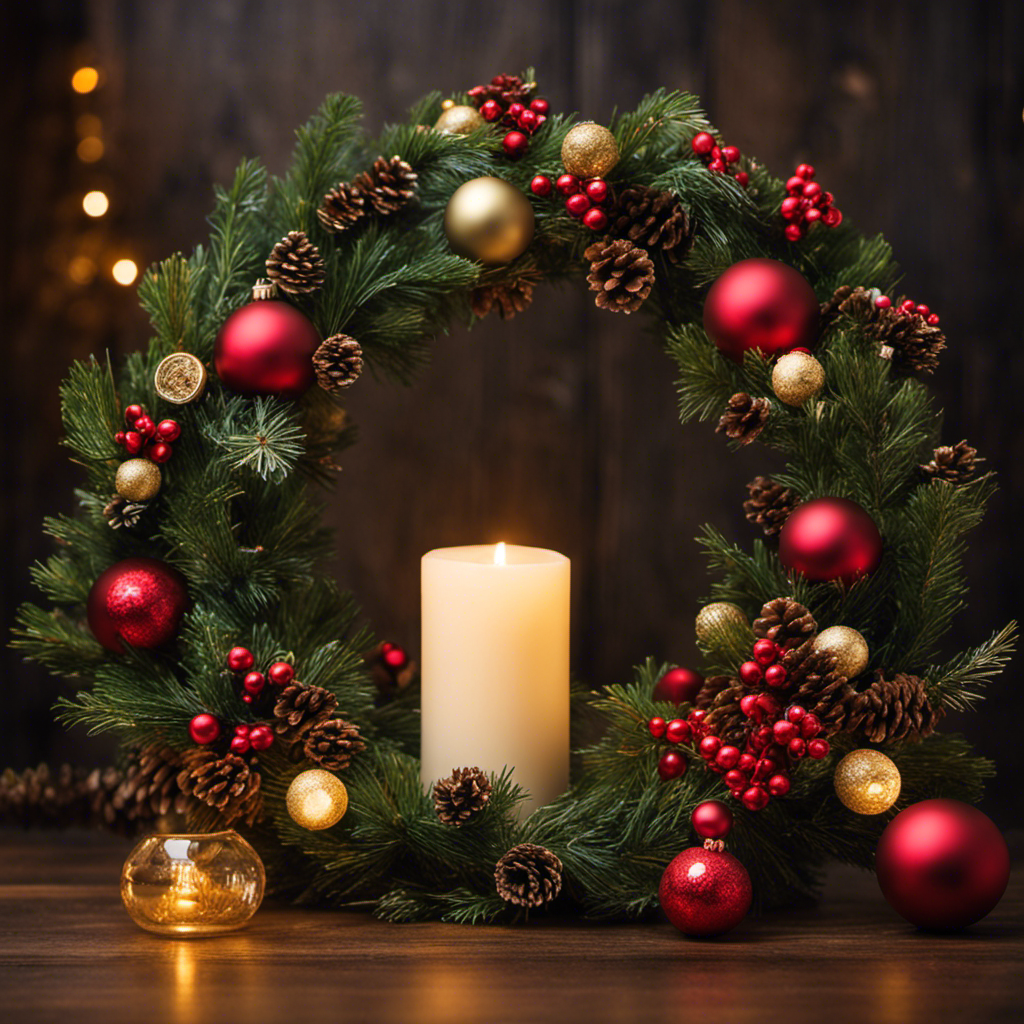
‘Tis the time to decorate the halls and make our homes festive and cheerful!
Join me on a jolly adventure as I show you how to create stunning Christmas decor that will bring joy to your heart and warmth to your abode.
From choosing the perfect theme to crafting homemade ornaments, we’ll explore a myriad of creative and festive ideas.
So grab your crafting supplies and let’s dive into the enchanting world of DIY Christmas decor!
Key Takeaways
- Consider personal preferences and overall home style when choosing a theme and gathering materials for Christmas decor.
- Incorporate unique decorations and one-of-a-kind pieces to add charm and create a memorable atmosphere.
- Gather materials like pinecones and dried leaves to create festive wreaths, using a sturdy base and attaching elements with hot glue or floral wire.
- Create homemade ornaments using various materials such as popsicle sticks, old light bulbs, and glass ornaments, and decorate them with paint, tissue paper, and embellishments.
Choosing the Perfect Theme
When choosing the perfect theme for your Christmas decor, it’s important to consider your personal preferences and the overall style of your home.
One of the key elements in creating a cohesive and visually appealing Christmas decor is choosing the right color scheme. Whether you prefer traditional red and green or a more modern and trendy color combination like silver and blue, selecting a color scheme will help guide your decorating decisions and create a harmonious look.
Additionally, selecting unique decorations can add a touch of personality and charm to your Christmas decor. From handmade ornaments to vintage finds, incorporating one-of-a-kind pieces will make your decorations stand out and create a memorable holiday atmosphere.
Now that you have chosen your theme and color scheme, it’s time to gather the materials and supplies needed to bring your vision to life.
Gathering Materials and Supplies
Once you have all your materials and supplies ready, start by organizing them in a convenient and accessible way.
Creating a budget-friendly Christmas decor doesn’t have to be a daunting task. With a little creativity and resourcefulness, you can transform simple items into unique and eye-catching decorations.
Here are three items that can inspire you to create one-of-a-kind Christmas decor:
-
Natural elements: Take a walk outside and gather pinecones, twigs, and dried leaves. These can be used to make rustic ornaments or garlands, adding a touch of nature to your holiday decorations.
-
Upcycled materials: Look around your house for items that can be repurposed. Consider using old jars as candle holders or turning wine corks into charming ornaments. Not only will this save you money, but it will also give your decor a personal touch.
-
DIY crafts: Get inspired by browsing online platforms or visiting local craft stores. Look for tutorials on creating paper snowflakes, fabric wreaths, or homemade stockings. These DIY projects are not only budget-friendly but also allow you to unleash your creativity.
Now, let’s transition into the next section where we will explore the art of creating festive wreaths.
Creating Festive Wreaths
To create a festive wreath, you can gather materials such as pinecones, twigs, and dried leaves. Making holiday crafts is a wonderful way to add a personal touch to your home decor.
Incorporating natural elements into your wreath not only brings a rustic charm but also connects you to the beauty of nature during the holiday season. Start by finding a sturdy base, such as a wire wreath frame or a grapevine wreath. Attach the pinecones, twigs, and dried leaves to the base using hot glue or floral wire. Arrange them in a balanced and visually appealing manner.
As you work on your wreath, think about color coordination and texture to create a harmonious design.
Now, let’s move on to crafting homemade ornaments.
Crafting Homemade Ornaments
You can use everyday household items and a dash of creativity to create unique homemade ornaments. Here are three ideas to get you started:
-
Personalized snowflakes: Cut out snowflakes from white cardstock or use popsicle sticks to create a snowflake shape. Decorate them with glitter, paint, or markers, and add your initials or names for a personalized touch.
-
Upcycling ornaments: Take old light bulbs or glass ornaments and give them new life. Paint them with acrylic paint or cover them with colorful tissue paper. Add embellishments like sequins, ribbons, or beads to make them truly one-of-a-kind.
-
Nature-inspired ornaments: Gather pinecones, acorns, or twigs from your backyard and turn them into beautiful ornaments. Paint them in festive colors or add a touch of glitter. Attach a string or ribbon to hang them on your Christmas tree.
Now that you’ve crafted your homemade ornaments, let’s move on to creating stunning DIY Christmas centerpieces.
DIY Christmas Centerpieces
Now that you’ve finished crafting your homemade ornaments, let’s explore some creative and festive ideas for your DIY Christmas centerpieces. One popular option is to create a rustic centerpiece with a floral arrangement. This combines the natural beauty of flowers with the cozy charm of rustic elements. To achieve this look, you can use a combination of fresh flowers, pinecones, and greenery. Arrange them in a wooden crate or a distressed metal container for a rustic touch. Add some candles for a warm and inviting ambiance. Here is an example of how you can arrange your rustic centerpiece:
| Column 1 | Column 2 | Column 3 |
|---|---|---|
| Fresh flowers | Pinecones | Greenery |
| Roses | Birch branches | Eucalyptus |
| Carnations | Cinnamon sticks | Boxwood |
| Poinsettias | Acorns | Holly berries |
This table showcases the different elements you can incorporate to create a stunning rustic centerpiece. Now, let’s move on to the next section about decorating with fairy lights.
Decorating With Fairy Lights
When it comes to creating a cozy and magical atmosphere, fairy lights are the perfect addition to your holiday decorations. They have a way of instantly transforming any space into a whimsical wonderland.
Here are three creative ways to incorporate hanging fairy lights into your outdoor fairy light displays:
-
Create a sparkling canopy: Hang fairy lights from trees or pergolas to create a mesmerizing canopy of twinkling lights. This will not only add a touch of enchantment to your outdoor space but also provide a warm and inviting ambiance for gatherings and celebrations.
-
Light up pathways: Line your garden pathways with fairy lights to create a magical walkway. This will not only guide your guests but also create a stunning visual effect when the lights reflect off the surrounding plants and foliage.
-
Decorate trees and shrubs: Wrap fairy lights around the branches of trees and shrubs to give them a festive makeover. This will instantly transform your outdoor space into a magical winter wonderland.
Now, let’s move on to making handmade garlands without missing a beat.
Making Handmade Garlands
Creating your own handmade garlands is a fun and festive way to add a personal touch to your holiday decorations. Whether you’re looking to make paper snowflakes or create personalized stockings, there are endless possibilities for creating unique garlands that reflect your style and creativity.
To get started, gather your materials and set up a crafting space. You’ll need scissors, string or ribbon, and any additional decorations you’d like to incorporate. Then, let your imagination run wild! Cut out various shapes, such as snowflakes, stars, or stockings, from colored paper or fabric. Attach them to the string or ribbon using glue or tape, spacing them out evenly to create a visually appealing pattern. Hang your handmade garland above the fireplace, across a doorway, or along the banister to instantly transform your space into a winter wonderland. Get ready to impress your guests with your DIY skills and add a personal touch to your holiday decor!
Here’s a table to inspire your creativity:
| Garland Theme | Materials Needed |
|---|---|
| Snowflake | Colored paper, string |
| Stocking | Fabric, ribbon |
| Star | Cardstock, twine |
| Holly | Felt, jute rope |
Frequently Asked Questions
How Do I Hang the Wreath on My Front Door Securely?
To hang my wreath securely on my front door, I’ll make a wreath hanger using a sturdy ribbon or wire. If I don’t have one, I can use a Command hook or an over-the-door hook as alternatives.
What Are Some Creative Ways to Display Homemade Ornaments?
I love finding creative ways to display homemade ornaments! One idea is to hang them from a tree branch in a vase or create a unique ornament display using a rustic ladder. Get crafty and have fun!
Can I Use Artificial Flowers in My DIY Christmas Centerpiece?
Sure, I can use artificial flowers in my DIY Christmas centerpiece. They’re a great alternative to fresh flowers and still add a festive touch. Plus, they last longer, saving me time and effort.
How Do I Safely Decorate With Fairy Lights Outdoors?
In order to safely decorate outdoors with fairy lights, it is important to follow some tips. Securely hang the lights using hooks or clips, make sure they are weatherproof, and avoid overloading electrical outlets.
What Are Some Unique Materials I Can Use to Make Handmade Garlands?
I love using upcycled paper and dried fruit to make unique garlands. They add a charming and eco-friendly touch to my Christmas decor. Plus, they’re easy to make and give a rustic feel to any space.
Conclusion
In conclusion, making your own Christmas decor is not only a fun and rewarding experience, but it also allows you to unleash your creativity and add a personal touch to your holiday festivities.
From choosing the perfect theme to crafting homemade ornaments, the possibilities are endless.
With just a few materials and some imagination, you can transform your home into a winter wonderland that will leave your guests in awe.
So why settle for store-bought decorations when you can create unique and stunning pieces that will be the envy of all?
Get ready to dazzle and impress this Christmas season with your handmade masterpieces!
- About the Author
- Latest Posts
Meet Bethia, the visionary designer at ByRetreat who brings a touch of magic to every remote workspace she creates. With a boundless imagination and an eye for beauty, Bethia is passionate about transforming ordinary spaces into extraordinary havens of creativity and comfort.
Bethia possesses a unique talent for envisioning the perfect combination of furniture, colors, and textures that harmonize seamlessly in a room. She understands that selecting furniture goes beyond mere functionality; it’s about curating pieces that evoke a sense of style and sophistication while enhancing the overall ambiance.
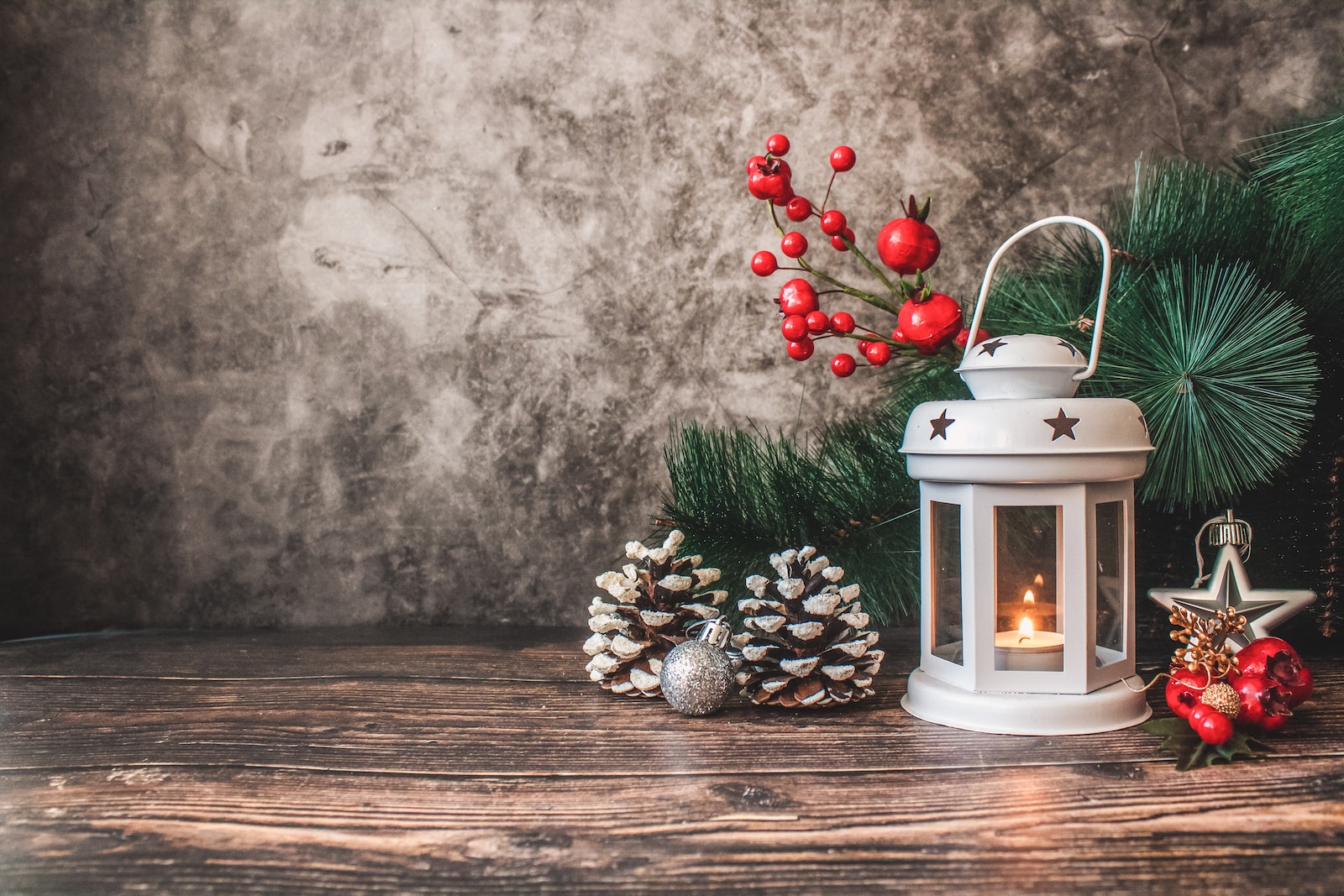
I recall the time when I forgot to take down my Christmas decorations until February. It wasn’t on purpose, but with a hectic schedule, time just got away from me.
The sight of those twinkling lights and festive ornaments still brought me joy, even as Valentine’s Day approached. But I soon realized that there are varying opinions on when to take down Christmas decor.
So, if you’re wondering whether it’s time to bid farewell to the holiday cheer, let’s explore the factors that can influence this decision.
Key Takeaways
- The timeline for taking down Christmas decor is a personal choice, but it is traditionally done after the twelfth night, which marks the end of the Christmas season for many cultures.
- Different cultures have specific dates and customs associated with removing Christmas decor, such as keeping decorations up until January 19th in some Eastern European countries and until January 6th (Epiphany) in Latino communities.
- Understanding cultural nuances and respecting traditions is important for holiday celebrations and fosters inclusiveness and tolerance.
- Weather considerations, such as waiting for a dry day or taking down outdoor decorations in freezing temperatures, should be taken into account when deciding when to take down Christmas decor.
The Traditional Timeline
If you follow the traditional timeline, you should start taking down your Christmas decor after the twelfth night. Cultural traditions play a significant role in determining when to remove Christmas decorations.
The twelfth night, also known as Epiphany, falls on January 6th and marks the end of the Christmas season for many cultures. It is believed to be the day when the three wise men visited baby Jesus. Taking down decorations on or before this day is seen as a way to honor this event.
However, it’s important to note that the timeline for taking down Christmas decor is ultimately a personal choice. Some people may prefer to keep their decorations up longer for various reasons, such as enjoying the festive ambiance or extending the holiday spirit.
Cultural differences further shape the specific dates and customs associated with removing Christmas decor, creating a rich tapestry of traditions around the world.
Cultural Differences
When it comes to cultural differences, you may want to consider the appropriate timing for removing your holiday decorations.
Cultural celebrations and holiday traditions vary from country to country, and as a result, the time for taking down decorations can also differ.
For example, in many Western countries, it is common to take down Christmas decorations shortly after the New Year. However, in some Eastern European countries, such as Russia and Ukraine, decorations are traditionally kept up until January 19th, which is known as ‘Old New Year.’
Additionally, in many Latino communities, decorations are often kept up until January 6th, which is the day of the Epiphany.
Understanding these cultural nuances and respecting the traditions of others is important when it comes to holiday celebrations.
Now let’s move on to religious observances.
Religious Observances
When it comes to discussing cultural diversity and traditions, the significance of religious observances and respect for different beliefs are key points to consider.
Understanding and appreciating the various customs and practices of different cultures can help us foster a sense of inclusiveness and tolerance.
Cultural Diversity and Traditions
You should consider the cultural diversity and traditions in your neighborhood before taking down your Christmas decorations. Cultural adaptation is an important aspect of living in a diverse community, and being mindful of the holiday traditions of others can help foster understanding and respect. To help you navigate this, I have created a table that highlights some common holiday traditions and their respective dates across different cultures:
Culture Holiday Date Christian Christmas December 25 Jewish Hanukkah Varies Hindu Diwali Varies Muslim Eid al-Fitr Varies Chinese Lunar New Year Varies
Significance of Religious Observances
To understand the significance of religious observances, it’s important to learn about the traditions and beliefs associated with different holidays. Religious practices vary greatly across cultures and have their roots in historical context.
These observances often serve as a way for individuals to connect with their spirituality and express their faith. For example, in Christianity, the observation of Lent is a time of fasting and reflection leading up to Easter, symbolizing the forty days Jesus spent in the desert. Similarly, in Islam, the holy month of Ramadan is a time of fasting from sunrise to sunset, emphasizing self-discipline and spiritual growth.
Understanding the historical context and practices of these religious observances allows for greater appreciation and respect for different beliefs, fostering a more inclusive and tolerant society.
Respect for Different Beliefs
Respecting different beliefs is essential for fostering a more inclusive and tolerant society. Cultural tolerance and understanding can help us create a world where everyone feels accepted and valued.
Here are four practical ways to show respect for different beliefs and promote cultural tolerance:
-
Educate yourself: Take the time to learn about different cultures and religions. This will help you understand their beliefs, traditions, and customs.
-
Listen and engage: When interacting with individuals from different backgrounds, listen actively and engage in meaningful conversations. This will allow you to gain insight into their perspectives and experiences.
-
Embrace diversity: Celebrate the diversity of beliefs and traditions by participating in cultural events and festivals. This shows your appreciation for different cultures and promotes inclusion.
-
Respect family traditions: Understand that family traditions are deeply rooted in personal beliefs and values. Avoid judgment or criticism, and instead, show respect for these traditions.
By practicing cultural tolerance and respecting different beliefs, we can create a more inclusive and harmonious society.
Transitioning into the next section about personal preference, it is important to consider individual choices when it comes to matters like taking down Christmas decorations.
Personal Preference
It’s entirely up to you when you decide to take down your Christmas decorations. Personal preferences and emotional attachment play a big role in this decision.
Some people like to keep the festive spirit alive for as long as possible, while others prefer to start the new year with a fresh slate. If you have sentimental attachments to certain ornaments or decorations, it might be harder to part with them.
However, it’s important to remember that there is no right or wrong time to take down your decorations. Trust your instincts and do what feels right for you.
That being said, once the holiday season is over, many people experience what is commonly known as the ‘post-holiday blues.’ This is a natural feeling and there are ways to cope with it.
Post-Holiday Blues
If you’re feeling a little down after the holidays, know that it’s completely normal and there are ways to help lift your spirits. The post-holiday nostalgia can be overwhelming, but there are coping strategies that can make this transition easier.
Here are a few things that have worked for me:
-
Reflect on the good times: Take some time to look through your holiday photos and relive the happy moments. This can help you appreciate the memories and bring a smile to your face.
-
Set new goals: The start of a new year is the perfect time to set new goals and focus on personal growth. Whether it’s learning a new skill or starting a new hobby, having something to look forward to can help combat the post-holiday blues.
-
Stay connected: Reach out to friends and family members and plan some get-togethers. Surrounding yourself with loved ones can provide a sense of comfort and support.
-
Practice self-care: Take care of yourself both physically and mentally. Engage in activities that make you happy, such as exercising, reading, or practicing mindfulness. Remember to be kind to yourself during this transition period.
As the holiday season comes to an end, it’s important to consider the weather before taking down your Christmas decorations.
Weather Considerations
When you’re deciding whether or not to remove your holiday decorations, it’s important to consider the current weather conditions. Taking down decorations can be a daunting task, but doing it at the right time can make the process easier and more efficient. Here are some weather considerations to keep in mind for your post-holiday cleanup:
Weather Condition Recommendation Rainy or Snowy Wait for a dry day Windy Secure decorations Freezing Temperatures Take down outdoor decorations Mild and Sunny Start the cleanup
New Year’s Resolutions
Now that the holidays are over, you can start thinking about your New Year’s resolutions. It’s common to experience post-holiday blues, but setting goals for the upcoming year can help bring a sense of purpose and motivation.
When it comes to New Year’s resolutions, it’s important to be practical and realistic. Start by reflecting on the past year and identifying areas where you’d like to make improvements. Whether it’s focusing on health and fitness, personal growth, or career goals, make sure your resolutions are specific and measurable. Break them down into smaller, achievable steps to keep yourself motivated throughout the year.
By setting New Year’s resolutions, you can overcome the post-holiday blues and start the year on a positive note.
Speaking of starting the year on a positive note, one practical aspect to consider is the availability of storage space for your holiday decorations.
Storage Space Availability
When it comes to storage space availability, many people face the challenge of limited options. Whether it’s due to a small living space or an excess of belongings, finding a place to store items can be a real struggle.
However, there are solutions to this problem. One option is to find alternative storage options. This could include renting a storage unit or utilizing unused space in your home, such as under the bed or in the attic. Another solution is to utilize temporary storage solutions. This could involve using storage bins or shelves to maximize the space you do have.
Limited Storage Options
If you’re running out of space, you can consider repurposing everyday items to store your Christmas decor. Limited storage solutions can be a challenge, but with a little creativity, you can find unique ways to store and display your holiday decorations.
One option is to use clear plastic bins or storage containers to keep your ornaments, lights, and other small items organized and protected. Another idea is to repurpose shoe organizers or hanging jewelry organizers to store wreaths, garlands, and other larger decorations.
You can also use old suitcases or trunk-style coffee tables to store and display your Christmas decor. By thinking outside the box and utilizing everyday items, you can maximize your storage space and create a visually appealing display.
Now, let’s explore some alternative storage options for your Christmas decor.
Finding Alternative Storage
One way to maximize storage space for your Christmas decorations is by repurposing everyday items. Instead of buying expensive storage containers, consider using items you already have around the house.
For example, use empty egg cartons to store fragile ornaments, or repurpose shoeboxes to hold smaller decorations. You can also use plastic storage bags to keep lights and garlands tangle-free.
Another alternative storage option is utilizing unused suitcases or duffel bags to store larger items like wreaths or Christmas tree skirts. By repurposing these everyday items, you can save money and make the most of the space you have available.
Now that you have alternative storage ideas, let’s explore how to utilize temporary storage for your post-holiday organization.
Utilizing Temporary Storage
Utilize temporary storage options to keep your holiday decorations organized and out of the way until next year. When it comes to organizing Christmas decorations, having the right storage solutions is essential. Here are some practical tips to help you keep your decorations safe and easily accessible:
- Invest in plastic storage bins: These bins are durable, stackable, and protect your decorations from moisture and pests.
- Use dividers and compartments: Keep fragile ornaments and lights separate by using dividers or small boxes within the storage bins.
- Label everything: Make sure to label each storage bin with a detailed list of its contents. This will save you time and effort when you need to find specific decorations next year.
By following these simple steps, you can ensure that your holiday decorations are stored properly and ready for use again next year.
Now, let’s move on to discussing festive events and celebrations without skipping a beat.
Festive Events and Celebrations
When it comes to festive events and celebrations, you should consider taking down your Christmas decor once the event or celebration has ended. Festive decorations are meant to enhance the holiday spirit and create a joyful atmosphere during these special occasions. However, leaving them up for too long can make your space feel cluttered and out of season.
It is important to respect holiday traditions and maintain a sense of order in your home. By promptly removing your Christmas decorations once the event or celebration is over, you can ensure a smooth transition back to your regular décor. This also allows you to fully embrace the next holiday or season without any lingering reminders of the past.
Speaking of traditions, let’s now delve into the fascinating world of superstitions and beliefs surrounding taking down Christmas decor.
Superstitions and Beliefs
To ensure good luck and ward off any negative energy, it’s considered auspicious in many cultures to remove your holiday decorations before the new year begins. This belief is rooted in superstitions and symbolism that have been passed down through generations.
The historical origins of this practice can be traced back to ancient times when people believed that the presence of decorations in the house after the new year would bring bad luck and hinder the arrival of positive energy. Taking down the decorations before the new year is seen as a way to start fresh and invite good fortune for the coming year.
Taking Down Decor With Purpose
As I start the process of removing my holiday decorations, I remember to be intentional with each item I pack away. Taking down decorations can be a tedious task, but organizing storage properly will make next year’s decorating a breeze.
Here are three tips to help you take down and organize your holiday decor with purpose:
-
Sort and categorize: As you pack away each decoration, take the time to sort and categorize them. This will make it easier to find specific items next year and ensure that everything is stored in an organized manner.
-
Use proper storage containers: Invest in sturdy storage containers specifically designed for holiday decorations. These containers will protect your decor from damage and make it easier to stack and store them neatly.
-
Label everything: Don’t forget to label each container with its contents. This will save you time and frustration when you are searching for specific items next holiday season.
Frequently Asked Questions
Can I Leave My Christmas Decorations up All Year Round?
Sure, I can leave my Christmas decorations up all year round, but it may not be practical. Year-round decor can be overwhelming and take away from the special feeling of the holiday season.
Are There Any Superstitions or Beliefs Associated With Taking Down Christmas Decorations?
Superstitions and cultural beliefs surround the act of taking down Christmas decorations. It’s fascinating how different traditions dictate various auspicious dates or times. Let’s explore the intriguing world of these beliefs and customs.
How Do You Take Down Decor With Purpose?
When taking down Christmas decor, I approach it with purpose. I start by decluttering, sorting items into purposeful storage containers. I also take this time to clean and organize, ensuring everything is ready for next year’s festivities.
Should I Consider Weather Conditions When Deciding When to Take Down My Christmas Decorations?
Considering weather conditions when taking down Christmas decorations is important. It can help prevent damage and ensure a smoother process. Practical tips include checking the forecast, picking a dry day, and storing items properly.
Are There Any Festive Events or Celebrations That Influence When I Should Take Down My Christmas Decor?
Festive traditions and cultural influences can impact when I take down my Christmas decor. Events like Epiphany or the end of the holiday season are often considered appropriate times to remove decorations.
Conclusion
In conclusion, deciding when to take down Christmas decor is a personal choice that can be influenced by various factors. Whether it’s following the traditional timeline, considering cultural or religious observances, or simply following personal preference, there is no right or wrong answer.
However, it’s important to keep in mind storage space availability, post-holiday blues, and even superstitions and beliefs.
So, when it comes to taking down your festive decorations, remember the saying ‘out with the old, in with the new’ and do what feels right for you.
- About the Author
- Latest Posts
Meet Katherine, the creative enthusiast at ByRetreat who infuses her boundless passion for design into every remote workspace she crafts. With an innate sense of creativity and an eye for unconventional beauty, Katherine brings a unique and inspiring perspective to the team.
Katherine’s love for design is infectious, and her ability to think outside the box sets her apart. She believes that true artistry lies in embracing a variety of styles and mixing them harmoniously to create captivating spaces. By combining different textures, colors, and patterns, Katherine weaves a tapestry of creativity that breathes life into each remote workspace.
-

 Decor1 week ago
Decor1 week agoMaximalist Decor Explained: Embrace More Style
-

 Vetted2 weeks ago
Vetted2 weeks ago15 Best Foot Massagers for Neuropathy to Soothe Your Feet and Relieve Discomfort
-

 Vetted3 weeks ago
Vetted3 weeks ago15 Best Sports Laundry Detergents for Keeping Your Activewear Fresh and Clean
-

 Vetted3 weeks ago
Vetted3 weeks ago15 Best Tall Toilets for Seniors That Combine Comfort and Safety
-

 Vetted4 weeks ago
Vetted4 weeks ago15 Best Dish Scrubbers to Keep Your Kitchen Sparkling Clean
-

 Vetted2 days ago
Vetted2 days ago15 Best Cleaners for Fiberglass Showers to Keep Your Bathroom Sparkling Clean
-

 Decor4 weeks ago
Decor4 weeks agoWhat Is Eclectic Home Decor
-

 Vetted7 days ago
Vetted7 days ago15 Best Organic Pest Control Solutions for a Naturally Pest-Free Home






















